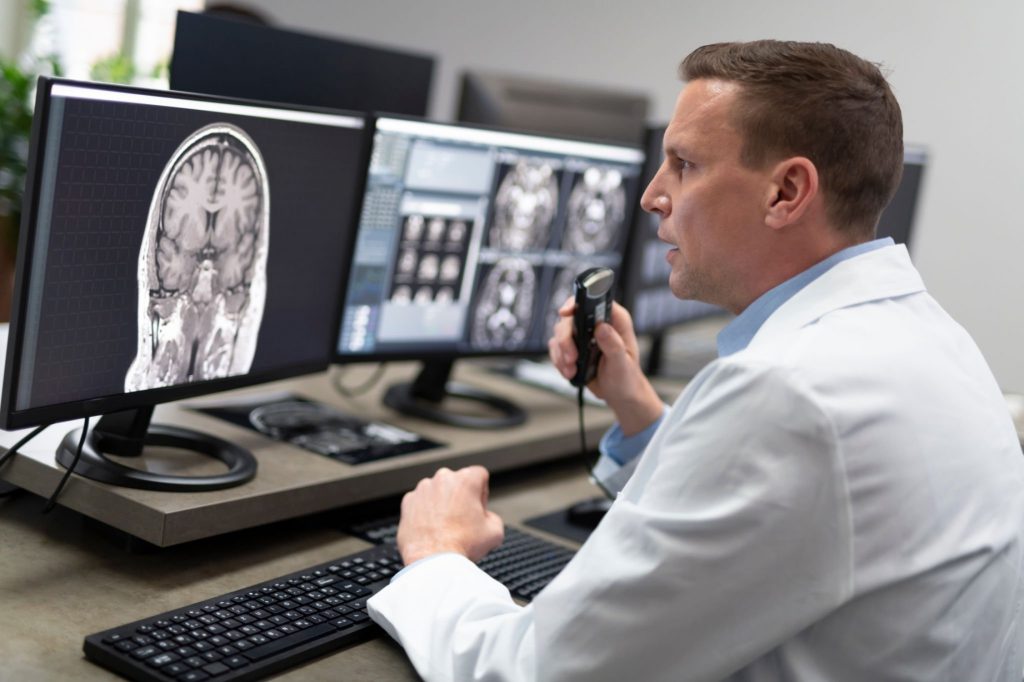Introduction
Teleradiology (Reporting of radiology images remotely) is gaining more importance day by day and is being widely considered as an effective option by Healthcare experts. However, it also involves the use of sophisticated imaging equipment which can act as an able substitute to lack of adequate staff with desirable experience.
Teleradiology is the electronic transmission of medical imaging studies CT, MRI, or X-Ray from one location to another. For this process to be implemented, three essential components are required:
- An image sending station
- A transmission network
- A receiving/image review station
Teleradiology allows radiologists to provide services without actually having to be at the location of the patient. This is particularly important when a sub-specialist such as an MRI radiologist, neuroradiologist, pediatric radiologist, or musculoskeletal radiologist is needed, since these professionals are generally only located in large metropolitan areas working during daytime hours. Teleradiology allows for trained specialists to be available 24/7.
Reporting process
Teleradiologists can provide a Preliminary Read for emergency room cases and other emergency cases or a Final Read for the official patient record and for use in billing.
Preliminary Reports include all pertinent findings and a phone call for any critical findings. For some Teleradiology services, the turnaround time is extremely rapid with a 30-minute standard turnaround and expedited for critical and stroke studies.
Teleradiology Final Reports can be provided for emergency and non-emergency studies. Final reports include all findings and require access to prior studies and all relevant patient information for a complete diagnosis. Phone calls with any critical findings are signs of quality services.
Teleradiology Preliminary or Final Reports can be provided for all doctors and hospitals overflow studies. Teleradiology can be available for intermittent coverage as an extension of practices and will provide patients with the highest quality care.
Why are teleradiology solutions urgent?
The rapid spread of the coronavirus highlighted the value of telemedicine solutions, as a means of limiting person-to-person contact. This included the use of teleradiology tools to read images and communicate with referring physicians. Telemedicine provides continuity of care within healthcare facilities and patients, while also allowing safe distance without sacrificing the quality of care. In the past, telehealth was primarily offered to patients in underserved areas and for follow-up appointments for patients with established care, however, COVID-19 has given physicians a runway to extend virtual care to a greater portion of the patient population.
More provider organizations are embracing the remote radiology model, with radiologists working from home. And some in the field believe this trend could continue in the future. Several advances in teleradiology have made this option possible for the long term: the healthcare cloud, vendor-neutral archives, and Artificial Intelligence (AI.).
These technologies are reported to have led to reduced workload on radiologists, faster turn-around time for patients, and cost savings for hospitals. For hospitals, teleradiology presents an attractive alternative to having staff radiologists available twenty-four hours a day.(link)

Benefits of Teleradiology:
- More efficient use of radiology infrastructure. Hospitals focused on general radiological services can use teleradiology to send complex images to major medical centers for evaluation. In addition, clinical radiologists can seek a second opinion from a specialist without transferring the patient, thus minimizing patient discomfort and improving the efficiency of service delivery.
- Cost savings. Teleradiology solutions eliminate the need for travel and allow radiologists to work from anywhere that is most convenient and cost-efficient. Hospitals of all sizes can benefit from the strategic use of teleradiology solutions. Reduced radiology costs, immediate imaging results, and improved access all make a hospital more competitive and better able to serve the needs of their patients.
- Improved access to care. Teleradiology plays a significant role in improving service to rural areas and has the potential to alleviate the current shortage of radiologists, providing access to subspecialty radiologists in regions where healthcare disparities arise.
- Time savings. Teleradiology solutions enable radiologists to have immediate access to medical images over the internet via secure telecommunication links. This results in much faster access to highly specialized medical imaging reports and consultative services, all while limiting costs and overhead.
- After hour service. Teleradiology allows medical facilities to provide around the clock coverage while relieving the radiologists from the burden of being on-call at night.(link)

